ZHCSDP5E December 2010 – February 2017 TCA9554A
PRODUCTION DATA.
- 1 特性
- 2 应用范围
- 3 说明
- 4 修订历史记录
- 5 Pin Configuration and Functions
- 6 Specifications
- 7 Parameter Measurement Information
- 8 Detailed Description
- 9 Application and Implementation
- 10Power Supply Recommendations
- 11Layout
- 12器件和文档支持
- 13机械、封装和可订购信息
封装选项
机械数据 (封装 | 引脚)
散热焊盘机械数据 (封装 | 引脚)
- DW|16
订购信息
6 Specifications
6.1 Absolute Maximum Ratings(1)
over operating free-air temperature range (unless otherwise noted)| MIN | MAX | UNIT | |||
|---|---|---|---|---|---|
| VCC | Supply voltage | –0.5 | 6 | V | |
| VI | Input voltage(2) | –0.5 | 6 | V | |
| VO | Output voltage(2) | –0.5 | 6 | V | |
| IIK | Input clamp current | VI < 0 | –20 | mA | |
| IOK | Output clamp current | VO < 0 | –20 | mA | |
| IIOK | Input-output clamp current | VO < 0 or VO > VCC | ±20 | mA | |
| IOL | Continuous output low current through a single P-port | VO = 0 to VCC | 50 | mA | |
| IOH | Continuous output high current through a single P-port | VO = 0 to VCC | –50 | mA | |
| ICC | Continuous current through GND by all P-ports, INT, and SDA | 250 | mA | ||
| Continuous current through VCC by all P-ports | –160 | ||||
| Tj(MAX) | Maximum junction temperature | 100 | °C | ||
| Tstg | Storage temperature | –65 | 150 | °C | |
(1) Stresses beyond those listed under Absolute Maximum Ratings may cause permanent damage to the device. These are stress ratings only, which do not imply functional operation of the device at these or any other conditions beyond those indicated under Recommended Operating Conditions. Exposure to absolute-maximum-rated conditions for extended periods may affect device reliability.
(2) The input negative-voltage and output voltage ratings may be exceeded if the input and output current ratings are observed.
6.2 ESD Ratings
| VALUE | UNIT | |||
|---|---|---|---|---|
| V(ESD) | Electrostatic discharge | Human-body model (HBM), per ANSI/ESDA/JEDEC JS-001(1) | ±2000 | V |
| Charged-device model (CDM), per JEDEC specification JESD22-C101(2) | ±1000 | |||
(1) JEDEC document JEP155 states that 500-V HBM allows safe manufacturing with a standard ESD control process. Manufacturing with less than 500-V HBM is possible with the necessary precautions.
(2) JEDEC document JEP157 states that 250-V CDM allows safe manufacturing with a standard ESD control process. Manufacturing with less than 250-V CDM is possible with the necessary precautions.
6.3 Recommended Operating Conditions
| MIN | MAX | UNIT | ||||
|---|---|---|---|---|---|---|
| VCC | Supply voltage | 1.65 | 5.5 | V | ||
| VIH | High-level input voltage | SCL, SDA | VCC = 1.65 V to 5.5 V | 0.7 × VCC | VCC(1) | V |
| A2–A0, P7–P0 | VCC = 1.65 V to 2.7 V | 0.7 × VCC | 5.5 | |||
| VCC = 3 V to 5.5 V | 0.8 × VCC | 5.5 | ||||
| VIL | Low-level input voltage | SCL, SDA | VCC = 1.65 V to 5.5 V | –0.5 | 0.3 × VCC | V |
| A2–A0, P7–P0 | VCC = 1.65 V to 2.7 V | –0.5 | 0.3 × VCC | |||
| VCC = 3 V to 5.5 V | –0.5 | 0.2 × VCC | ||||
| IOH | High-level output current | Any P-port, P7–P0 | –10 | mA | ||
| IOL | Low-level output current(2) | P00–P07, P10–P17 | Tj ≤ 65°C | 25 | mA | |
| Tj ≤ 85°C | 18 | |||||
| Tj ≤ 100°C | 9 | |||||
| INT, SDA | Tj ≤ 85°C | 6 | ||||
| Tj ≤ 100°C | 3 | |||||
| ICC | Continuous current through GND | All P-ports P7-P0, INT, and SDA | 200 | mA | ||
| Continuous current through VCC | All P-ports P7-P0 | –80 | ||||
| TA | Operating free-air temperature | –40 | 85 | °C | ||
(1) The SCL and SDA pins shall not be at a higher potential than the supply voltage VCC in the application, or an increase in leakage current, II, will result.
(2) For voltages applied above VCC, an increase in ICC will result.
6.4 Thermal Information
| THERMAL METRIC(1) | TCA9554A | UNIT | ||||
|---|---|---|---|---|---|---|
| PW (TSSOP) | DBQ (SSOP) | DB (SSOP) | DW (SOIC) | |||
| 16 PINS | 16 PINS | 16 PINS | 16 PINS | |||
| RθJA | Junction-to-ambient thermal resistance | 122 | 121.7 | 113.2 | 84.7 | °C/W |
| RθJC(top) | Junction-to-case (top) thermal resistance | 56.4 | 72.9 | 63.6 | 48 | °C/W |
| RθJB | Junction-to-board thermal resistance | 67.1 | 64.2 | 64 | 49.1 | °C/W |
| ψJT | Junction-to-top characterization parameter | 10.8 | 24.4 | 21.2 | 22.7 | °C/W |
| ψJB | Junction-to-board characterization parameter | 66.5 | 63.8 | 63.4 | 48.7 | °C/W |
(1) For more information about traditional and new thermal metrics, see the Semiconductor and IC Package Thermal Metrics application report.
6.5 Electrical Characteristics
over operating free-air temperature range (unless otherwise noted)| PARAMETER | TEST CONDITIONS | VCC | MIN | TYP(1) | MAX | UNIT | ||
|---|---|---|---|---|---|---|---|---|
| VIK | Input diode clamp voltage | II = –18 mA | 1.65 V to 5.5 V | –1.2 | V | |||
| VPORR | Power-on reset voltage, VCC rising | VI = VCC or GND, IO = 0 | 1.2 | 1.5 | V | |||
| VPORF | Power-on reset voltage, VCC falling | VI = VCC or GND, IO = 0 | 0.75 | 1 | V | |||
| VOH | P-port high-level output voltage(2) | IOH = –8 mA | 1.65 V | 1.2 | V | |||
| 2.3 V | 1.8 | |||||||
| 3 V | 2.6 | |||||||
| 4.5 V | 4.1 | |||||||
| IOH = –10 mA | 1.65 V | 1.1 | ||||||
| 2.3 V | 1.7 | |||||||
| 3 V | 2.5 | |||||||
| 4.5 V | 4 | |||||||
| IOL | SDA(4) | VOL = 0.4 V | 1.65 V to 5.5 V | 3 | 11 | mA | ||
| P port(3) | VOL = 0.5 V | 1.65 V | 8 | 10 | ||||
| 2.3 V | 8 | 13 | ||||||
| 3 V | 8 | 15 | ||||||
| 4.5 V | 8 | 17 | ||||||
| VOL = 0.7 V | 1.65 V | 10 | 14 | |||||
| 2.3 V | 10 | 17 | ||||||
| 3 V | 10 | 20 | ||||||
| 4.5 V | 10 | 24 | ||||||
| INT (5) | VOL = 0.4 V | 1.65 V to 5.5 V | 3 | 7 | ||||
| II | SCL, SDA | VI = VCC or GND | 1.65 V to 5.5 V | ±1 | μA | |||
| A2–A0 | ±1 | |||||||
| IIH | P port | VI = VCC | 1.65 V to 5.5 V | 1 | μA | |||
| IIL | P port | VI = GND | 1.65 V to 5.5 V | –100 | μA | |||
| ICC | Operating mode | VI = VCC or GND, IO = 0, I/O = inputs, fSCL = 400 kHz, no load |
5.5 V | 34 | μA | |||
| 3.6 V | 15 | |||||||
| 2.7 V | 9 | |||||||
| 1.95 V | 5 | |||||||
| Standby mode | I/O = inputs, fSCL = 0 kHz |
VI = VCC | 5.5 V | 1.9 | 3.5 | |||
| 3.6 V | 1.1 | 1.8 | ||||||
| 2.7 V | 1 | 1.6 | ||||||
| 1.95 V | 0.4 | 1 | ||||||
| VI = GND | 5.5 V | 0.45 | 0.7 | mA | ||||
| 3.6 V | 0.3 | 0.6 | ||||||
| 2.7 V | 0.23 | 0.5 | ||||||
| 1.95 V | 0.23 | 0.5 | ||||||
| Ci | SCL | VI = VCC or GND | 1.65 V to 5.5 V | 3 | 8 | pF | ||
| Cio | SDA | VIO = VCC or GND | 1.65 V to 5.5 V | 5.5 | 9.5 | pF | ||
| P port | 8 | 9.5 | ||||||
(1) All typical values are at nominal supply voltage (1.8-, 2.5-, 3.3-, or 5-V VCC) and TA = 25°C.
(2) Each P-port I/O configured as a high output must be externally limited to a maximum of 10 mA, and the total current sourced by all I/Os (P-ports P7-P0) through VCC must be limited to a maximum current of 80 mA.
(3) Each P-port I/O configured as a low output must be externally limited to a maximum of 25 mA, and the total current sunk by all I/Os (P-ports P7-P0, INT, and SDA) through GND must be limited to a maximum current of 200 mA.
(4) The SDA pin must be externally limited to a maximum of 12 mA, and the total current sunk by all I/Os (P-ports P7-P0, INT, and SDA) through GND must be limited to a maximum current of 200 mA.
(5) The INT pin must be externally limited to a maximum of 7 mA, and the total current sunk by all I/Os (P-ports P7-P0, INT, and SDA) through GND must be limited to a maximum current of 200 mA.
6.6 I2C Interface Timing Requirements
over operating free-air temperature range (unless otherwise noted) (see Figure 11)| MIN | MAX | UNIT | |||
|---|---|---|---|---|---|
| STANDARD MODE | |||||
| fscl | I2C clock frequency | 0 | 100 | kHz | |
| tsch | I2C clock high time | 4 | µs | ||
| tscl | I2C clock low time | 4.7 | µs | ||
| tsp | I2C spike time | 50 | ns | ||
| tsds | I2C serial-data setup time | 250 | ns | ||
| tsdh | I2C serial-data hold time | 0 | ns | ||
| ticr | I2C input rise time | 1000 | ns | ||
| ticf | I2C input fall time | 300 | ns | ||
| tocf | I2C output fall time | 10-pF to 400-pF bus | 300 | ns | |
| tbuf | I2C bus free time between Stop and Start | 4.7 | µs | ||
| tsts | I2C Start or repeated Start condition setup | 4.7 | µs | ||
| tsth | I2C Start or repeated Start condition hold | 4 | µs | ||
| tsps | I2C Stop condition setup | 4 | µs | ||
| tvd(data) | Valid data time | SCL low to SDA output valid | 3.45 | ns | |
| tvd(ack) | Valid data time of ACK condition | ACK signal from SCL low to SDA (out) low |
3.45 | µs | |
| Cb | I2C bus capacitive load | 400 | pF | ||
| FAST MODE | |||||
| fscl | I2C clock frequency | 0 | 400 | kHz | |
| tsch | I2C clock high time | 0.6 | µs | ||
| tscl | I2C clock low time | 1.3 | µs | ||
| tsp | I2C spike time | 50 | ns | ||
| tsds | I2C serial-data setup time | 100 | ns | ||
| tsdh | I2C serial-data hold time | 0 | ns | ||
| ticr | I2C input rise time | 20 | 300 | ns | |
| ticf | I2C input fall time | 20 × (VDD / 5.5 V) | 300 | ns | |
| tocf | I2C output fall time | 10-pF to 400-pF bus | 20 × (VDD / 5.5 V) | 300 | ns |
| tbuf | I2C bus free time between Stop and Start | 1.3 | µs | ||
| tsts | I2C Start or repeated Start condition setup | 0.6 | µs | ||
| tsth | I2C Start or repeated Start condition hold | 0.6 | µs | ||
| tsps | I2C Stop condition setup | 0.6 | µs | ||
| tvd(data) | Valid data time | SCL low to SDA output valid | 0.9 | ns | |
| tvd(ack) | Valid data time of ACK condition | ACK signal from SCL low to SDA (out) low |
0.9 | µs | |
| Cb | I2C bus capacitive load | 400 | pF | ||
6.7 Switching Characteristics
over operating free-air temperature range (unless otherwise noted) (see Figure 12 and Figure 13)| PARAMETER | FROM (INPUT) |
TO (OUTPUT) |
MIN | MAX | UNIT | ||
|---|---|---|---|---|---|---|---|
| STANDARD MODE and FAST MODE | |||||||
| tiv | Interrupt valid time | P port | INT | 4 | µs | ||
| tir | Interrupt reset delay time | SCL | INT | 4 | µs | ||
| tpv | Output data valid | SCL | P7–P0 | 350 | ns | ||
| tps | Input data setup time | P port | SCL | 100 | ns | ||
| tph | Input data hold time | P port | SCL | 1 | μs | ||
6.8 Typical Characteristics
TA = 25°C (unless otherwise noted)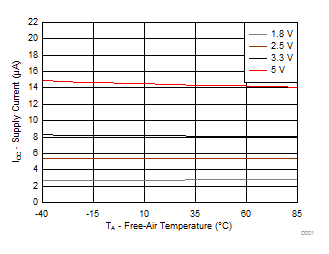
| fSCL = 400 kHz | I/Os = High or Low Inputs |
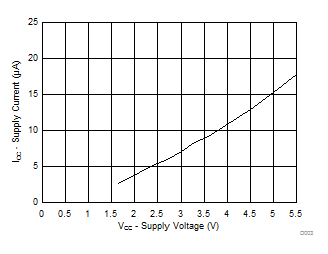
| fSCL = 400 kHz | I/Os = High or Low Inputs | TA = 25°C |
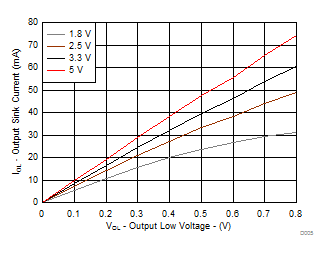
| TA = 25°C |
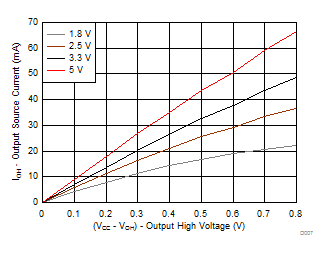
| TA = 25°C |
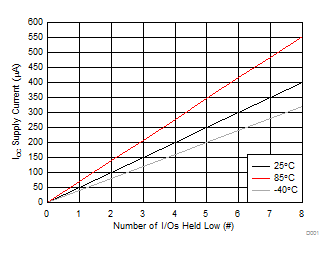
| VCC = 5 V |
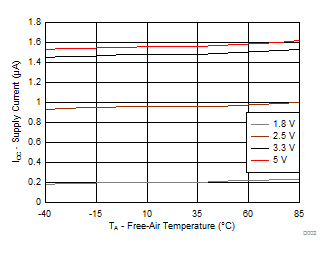
| fSCL = 0 kHz | I/Os = High Inputs |
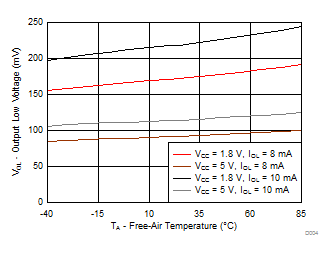
| I/Os = High or Low Inputs |
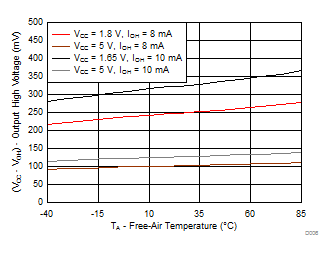
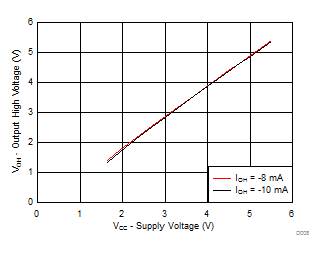
| TA = 25°C |
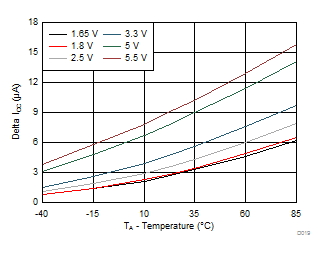
(VI = VCC – 0.6 V)